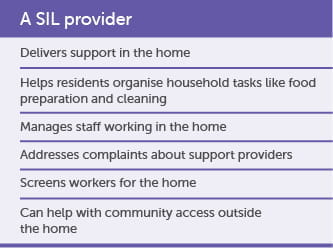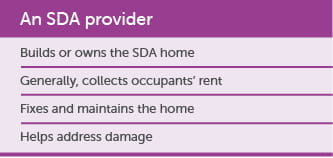SIL vs SDA – the differences explained
Are you unclear about how Supported Independent Living (SIL) and Specialist Disability Accommodation (SDA) differ? This article breaks down their key differences.
SIL. SDA.
These two acronyms are a source of constant confusion, often mistakenly thought to be one and the same.
That’s not the case.
While both are types of NDIS funding streams, they have stark distinctions.
In this article, we reveal the key differences between SIL and SDA – and explore other related questions – to help clear up the confusion.
This clarity can help people with disability, and their families, to find a lifestyle option best suited to their needs.

What is the difference between SIL and SDA?
The key difference between Supported Independent Living (SIL) and Specialist Disability Accommodation (SDA) is based on the way in which each funding stream assists an NDIS participant.
SIL relates to funding for support services that help participants to manage daily living tasks and live as independently as possible, while building skills.
Meanwhile, SDA pertains to funding for the actual brick-and-mortar accommodation in which those services are delivered.
SDA homes are specifically configured for people with ‘extreme functional impairments’. These homes include features and modifications designed to make daily life easier and safe for its residents.
In simple terms, think of SIL as the 'how' and SDA as the 'where'.
Let’s dive into these differences deeper by looking at what an NDIS participant could expect to receive from a SIL provider compared to an SDA provider.

SIL provider overview
A SIL provider manages the supports themselves.
Essentially, this means it supplies the staff to support people with disability with daily living tasks conducted in their homes.
Generally, this is undertaken with a focus on developing the individual’s skills, so they can live as independently as possible.
SDA provider overview
An SDA provider oversees the house itself – as in the physical structure – much like a landlord or property management agency.
The primary purpose of SDA is to make accessing supports easier.
SDA is generally only applied when a person has very high needs or ‘extreme functional impairments’. In fact, only a very small percentage of NDIS participants are eligible for SDA funding.
The table below is a quick and handy reference point that summarises the difference between SIL and SDA providers.


Can an organisation provide both services?
Yes, they can. At Endeavour Foundation, we are both a SIL provider and an SDA provider.
Can you receive funding for SIL and SDA?
An NDIS participant may be eligible for both SIL and SDA funding in some instances. If the individual does meet the requirements for both types of supports, the SIL and SDA funding will be recorded separately in their NDIS plan.
Want to know more about NDIS funding? It’s all here.

The SIL and SDA experts
Moving out of the family home is a big deal for people with disability, as it is for anyone.
If you want to know more about how we can support people with disability with their SIL or SDA needs – or if you have any questions about this topic – get in touch with us today.
Enquire